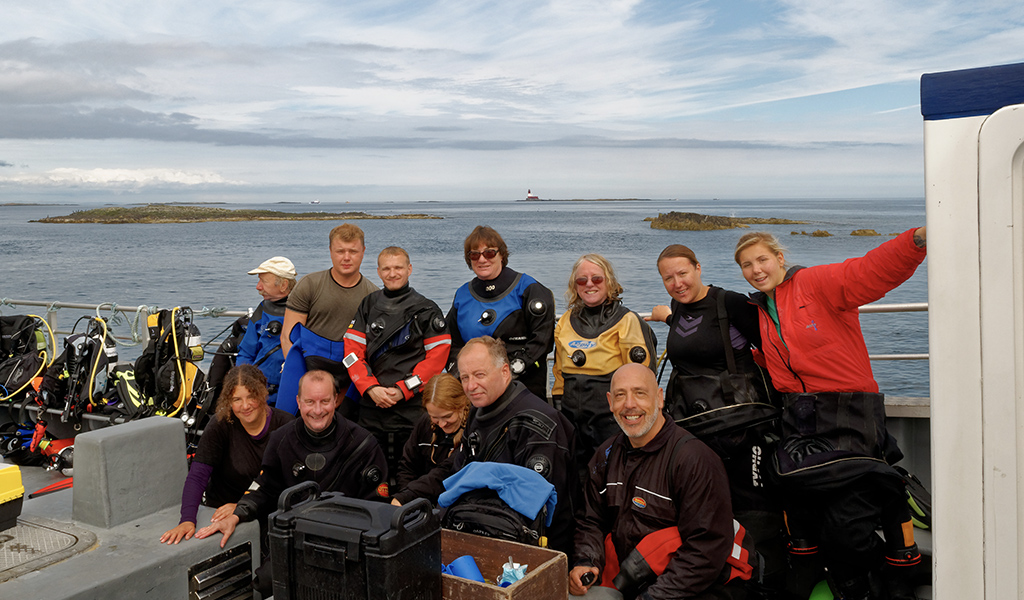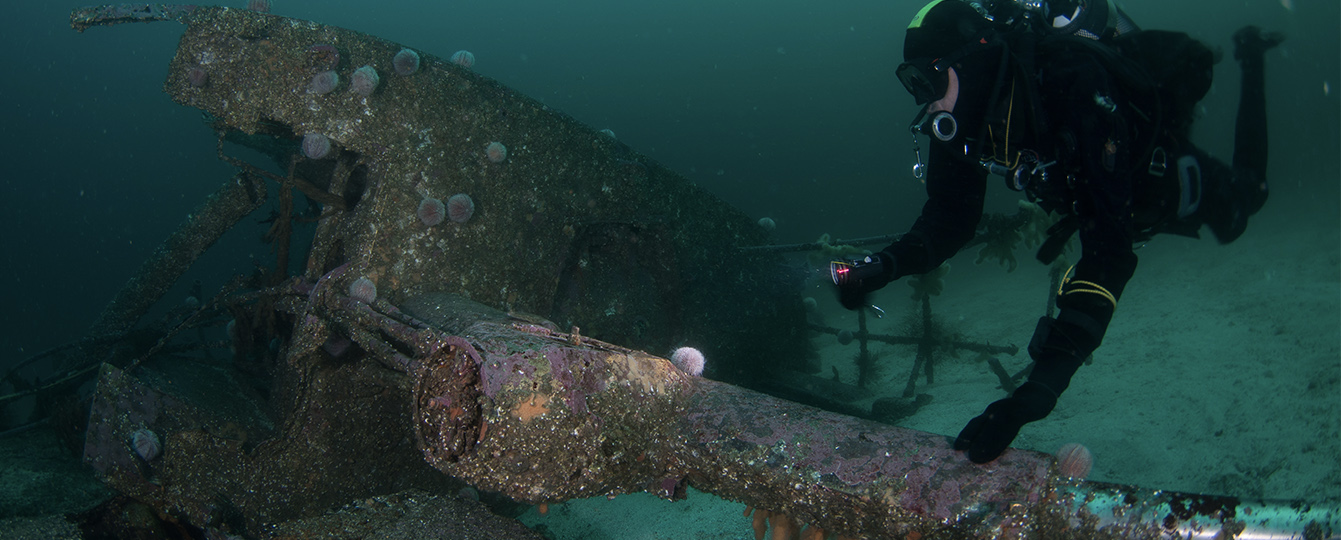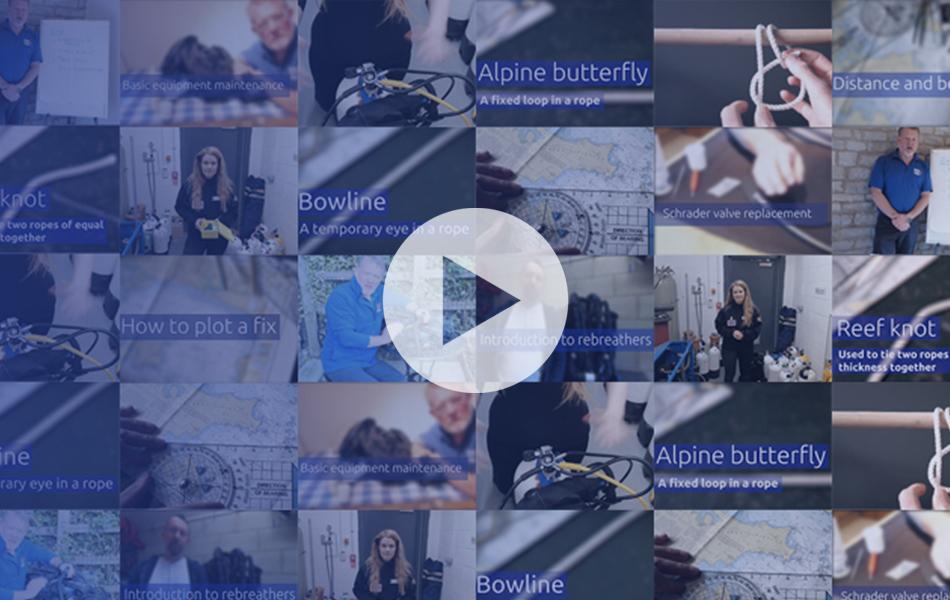
Still looking for things to do at home? In charge of rebooting the BSAC Expeditions Scheme, Andy Hunt has some progressive training tips for new expedition leaders so you can make a start planning the post-lockdown expedition of your dreams.
Some time ago, when co-writing the BSAC Expedition Manual, I pondered for a while about the definition of an expedition. We adapted the dictionary definition and came up with a “group of divers going diving for a purpose”. The purpose of the expedition drives the skills that members of the team need to have in order to accomplish the expedition safely, successfully and on budget. In a way, most dives could be defined as expeditions; but divers tend to reserve the term for something requiring a bit more effort than the norm.
As an expedition leader, you will certainly need to ensure you have appropriately qualified and skilled divers on the team. Instructors will be familiar with the iceberg analogy used to describe preparation; the bit you see (your presentation or lesson) constitutes a small proportion of the total effort required to get to that point (the 9/10ths that hides below the water). The same analogy could be applied to the preparations needed for a diving expedition, so let’s take a closer look at what qualifications and skillsets are required for success.
How does the Diver Training Programme help?
 First up is the BSAC Diver Training Programme (DTP). This does much to prepare divers with core skills for most expeditions and it does so in a way that is largely unnoticed. Ocean Diver prepares you to dive in closely supervised conditions, giving an understanding of those safe diving systems. Sports Diver gets you taking on more responsibility for your own diving with a buddy, and is the minimum entry-level qualification to access many Skill Development Courses (SDCs) including technical courses. Both of these grades have invaluable, in-built nitrox training.
First up is the BSAC Diver Training Programme (DTP). This does much to prepare divers with core skills for most expeditions and it does so in a way that is largely unnoticed. Ocean Diver prepares you to dive in closely supervised conditions, giving an understanding of those safe diving systems. Sports Diver gets you taking on more responsibility for your own diving with a buddy, and is the minimum entry-level qualification to access many Skill Development Courses (SDCs) including technical courses. Both of these grades have invaluable, in-built nitrox training.
Dive Leader starts adding dive management elements, moving you up the ladder to organising largely known groups of divers to largely known
locations. Advanced Diver builds on this, giving you the skills to take largely known groups (for instance your branch) to largely unknown locations; perhaps this grade should be called BSAC Expedition Diver given the training that is built into that grade and what most Advanced Divers actually do. First Class Diver moves on to organising largely unknown groups to largely unknown locations (such as within the BSAC Expeditions Scheme) with more of a focus on delivering an output, such as a project or mission.
Assessing personal skills
Expeditions need both leaders and participants, and qualifications are a simple way of initially assessing whether the dive team has the correct skills. This is, however, only the start. Experience in terms of quantity and quality of dives is also important. Fortunately, much of the Diver Training Programme needs divers to be going diving, so training and experience should be relatively easy to build-in to most dives.
In my early diving career, I recall many a successful expedition with the sole objective of getting club members the dives to complete their next grade. The instructors just happened to use a great dive trip to deliver the purpose. This wasn’t something I noticed at the time as I was focused on ticking the boxes in my qualification record book and in parallel in the pages of my diving logbook. For example, as a member of Loughborough University Sub-Aqua Club, I recall volunteering (or maybe being volunteered) to organise the annual club shore-diving expedition to St Abbs, in Scotland, to enable members to complete their initial training and make a substantial dent in their progress to Sports Diver. This also conveniently doubled as Advanced Diver training for myself as the expedition leader. With some 36 divers, many of whom had at that point only dived inland sites and not in the sea, this was quite an undertaking, but it was also very exciting.
A few years later, I recall instructing on an expedition organised by Southampton University SAC using RIBs and diving out of Fort Bovisand in Devon. This was again a whole week dedicated to getting members from the equivalent of Ocean Diver up to Sports Diver and the location was perfect to be able to cover the whole range of diving experiences required.
Setting prerequisites
More recently, for expeditions catering for the more experienced diver, I have set the pre-requisites at both a minimum qualification and a minimum number of dives, emphasising any key skills that divers need to have. For example, when doing some of the more extreme drift dives off the west coast of Scotland, there is a higher risk of separation from your buddy and so there is a need to be extremely confident and competent to launch your own delayed surface marker buoy (dSMB) from mid-water. For this sort of trip, I stipulated a minimum grade of Dive Leader (or equivalent) as the dSMB skill gets taught at this level, but I also did some check-out dives on more sedate sites beforehand before committing divers to the more hairy drifts.
For the expeditions that I’m planning for next season, I already have some pre-requisites in mind. The Outer Hebrides wreck-hunting expedition will require a minimum diver grade of Sports Diver (dive depths are expected to be mainly in the 20-25m range) and we will be diving from small boats and pumping our bottles and potentially mixing our own nitrox. So the skills set moves out of the standard core DTP and into the realm of BSAC Skill Development Courses (SDCs).
What do SDCs offer?

Skill Development Courses begin to build a diver’s wider skills but can also accelerate diver training. So for my upcoming expeditions, for example, a whole raft of BSAC SDCs can help fill any skills gaps: Boat Handling, Diver Coxswain, Chartwork and Position Fixing for those wanting to be in charge of boats. Compressor Operation and Gas Blending provide the skills for filling the tanks. I’m expecting most applicants to already have completed the Oxygen Administration course, which incidentally ticks many of the Dive Leader lecture boxes.
Now, some skills are simply best acquired before the expedition rather than trying to complete them as part of it. That way, you turn up with the knowledge to help rather than having to learn on the go. With SDCs, time is made to focus solely on the learning. However, there is no hard and fast rule here. On a recent expedition I ran, there were two experienced divers who needed to undertake their Diver Coxswain assessment. As soon as they mentioned this, they were made responsible for all the boat operations that week and, under supervision from qualified instructors, consolidated and honed their boat handling so that at the end of the week they were able to sit the Diver Coxswain assessment and pass with confidence and competence.
Looking back at the day-to-day run timeline of that particular expedition, running a full formal boat handling course at the same time would simply not have worked. There were simply not enough hours in the day to accomplish that effectively and deliver the expedition. However, building experience following on from the course and finding time for the assessment could be comfortably achieved in this case and worked well.
On another expedition I ran, its remote nature meant that a bit more thought needed to go into the provision of first aid. Well, that was probably the diplomatic way of saying that I was concerned about the ageing demographic of the team. While they were very experienced divers and fit to dive, their age put them in a higher category of suffering a cardiac event; well at least that was my perception. So we set about organising a BSAC Automated External Defibrillator (AED) course within the branch. This not only up-skilled the divers for the expedition and helped mitigate one of the risks I’d identified, but at the same time, it refreshed their basic resuscitation skills, raised awareness in the club and trained other club members. It also allowed the club to make an informed decision on buying an AED unit for the club to use alongside the oxygen kit.
Some practical notes on running SDCs
- For SDCs to run there needs to be a minimum number of students and a suitably qualified instructor, all available on the same date and time.
- As a student, booking early means your place is guaranteed and if the course is oversubscribed there is time to try to muster additional resource (instructors, classrooms) or, failing that, additional events.
- Taking a last-minute approach to booking means there is a risk of disappointment; there is a cut-off date by which most courses need to make a financial commitment for classrooms and facilities. I have cancelled a couple of events for this reason only to be faced with a flurry of last-minute requests that would have made the event viable only to find instructors and facilities were then no longer available.
- Most SDCs can be run in-branch, but if for some reason the branch cannot put on an event then see if there are any regional events running (in your own or other regions). Alternatively, try a BSAC Centre. Centres often offer BSAC courses on demand if there are enough students.
- A number of overseas centres offer diving all year round and over the winter period may be able to run courses (DTP and SDCs) to help accelerate your own or your branch’s training programmes.
How can technical training help?
Some sites need more specialist technical skills and BSAC offers a number of courses starting with Accelerated Decompression Procedures (ADP) and Twin-Set Diver, all the way up to closed and open-circuit mixed gas diving courses. While technical courses are generally associated with increasing safe access to depth by adding helium to the breathing gas mix and learning about the associated procedures and dive planning rigour that goes with it, the early ‘technical’ courses also offer much to divers who aren’t interested in depth so much.
For example, most sport diving is between the 20-30m range; perfect for nitrox. However, add into that mix the twin set course and some accelerated decompression and you can dramatically increase your bottom times, especially for second dives, when compared with air diving. They also introduce dive-planning discipline back into your diving, which is easy to forget when you strap a computer to your wrist. From the expedition leader’s point of view, this creates a few more considerations for gas fills, particularly if you are doing the filling yourselves (unless you have rebreather divers on the team, who are generally the compressor operator’s friends with such small bottles to fill).
Technical courses can be offered through the branch with suitably qualified instructors but are more usually run in regions by the BSAC Technical Team or at BSAC Centres (Find out more).

The endpoint
So far, we have covered skills getting us in and out of the water safely in the right location. So what are you going to do underwater? Well, this depends on the purpose of the expedition, which could simply be diving that particular site. Most branches nowadays rely on social media and the internet to get their message out, so having members who can capture good quality digital photographs in often challenging conditions is a very valuable asset; providing much-needed content for a website, (or even a future feature in SCUBA magazine?). The BSAC Underwater Photography Course is a great course that can develop a basic level of skills. We organised an in-branch course some years ago which proved to be great fun. We learnt a huge amount from the tutors; one from our branch and one from a neighbouring branch, both of whom were skilled photographers. And the quality and quantity of images available for the club’s Facebook page and website improved as a result.
If BSAC doesn’t yet have a course to help – there are more in the pipeline – the club also works with other bodies with similar and more specialised interests to promote specialist training. For example, the Marine Conservation Society offers SeaSearch, a citizen-science programme to help identify and record marine life and underwater habitats (complementary to BSAC’s Marine Life Appreciation Course), and the Nautical Archaeological Society offers training in practical underwater archaeology techniques (complementary to BSAC’s wreck diving and wreck appreciation courses).
So what would I advise every potential expedition leader?
- Decide what diving expeditions you want to organise and what skills participants will need.
- Get organised. Most branches decide on their dive plans well in advance. Winter can be a good time to get plans in place to support club expeditions, but thanks to our current predicament, now is also a good time to plan!
- Where the purpose of the expedition is diver training (such as to complete Ocean and Sports Diver qualifying dives), plan the expeditions carefully with expedition and instructing teams working in parallel to deliver.
- Plan any necessary skills training early and align everyone’s diaries before they get filled up. Generally try to learn new skills in advance of the expedition, so that you can concentrate on the expedition diving. Again, now is a great time to lay the groundwork for this training, possibly delivering some theory lessons online if possible.
- Check out the online training BSAC currently has to offer and see if any would be useful to take - book on as soon as possible!
For more information on BSAC expedition diving and the support and guidance on offer go to bsac.com/expeditions.
Join the BSAC community
The BSAC network is working together to keep people connected to the sport. With online training, special interest webinars, competitions, support to clubs and the trade, and much more...we'd love you to join us.
This Learning Curve was originally published in SCUBA magazine, Issue 100 March 2020. For more membership benefits, visit bsac.com/benefits.
Image credit: Barnsley BSAC Divers
Images in this online version may have been substituted from the original images in SCUBA magazine due to usage rights.




